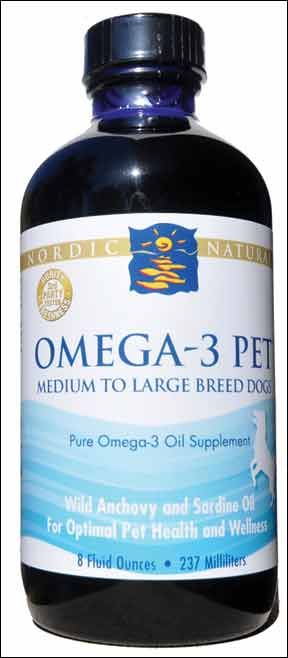Fish oil is probably the most important supplement you can add to your dog’s diet, regardless of what type of diet you feed. EPA and DHA, the omega-3 fatty acids in fish oil, provide widespread benefits, but they are fragile and unlikely to survive storage in bags of kibble, or may be rancid even before being added to pet foods. Krill oil and whole fish also provide EPA and DHA that may be better absorbed, providing similar benefits in smaller doses.
BENEFITS
Proven benefits from EPA and DHA include:
-Improving the coat and skin.
-Reducing inflammation due to conditions such as arthritis, allergies, and inflammatory bowel disease.
-Regulating the immune system, boosting those that are suppressed and calming overactive immune systems for dogs with allergies or autoimmune diseases.
-Aiding in mental development of fetuses and puppies, and improving cognitive function in older dogs.
-Lowering blood pressure and triglycerides.
-Providing support for dogs with kidney disease, heart disease, and cancer.
-Promoting weight loss in overweight dogs.
CAUTIONS
Fish oil should be protected from light, heat, and air. Store liquid fish oil in dark bottles in the refrigerator. Purchase amounts that can be used within one or two months to avoid rancidity. If you notice an “off” odor, discard the oil.
Independent agencies have tested many human and pet supplements. None have found mercury, but a few products had unsafe levels of PCBs, provided less EPA or DHA than was shown on the label, or were spoiled. For those concerned about contaminants, look for molecularly distilled products (note the term “pharmaceutical grade” has no legal definition). More concentrated forms, with higher amounts of EPA and DHA per gram, result in lower levels of contaminants.
Liquid fish oil products made for humans often contain flavorings that dogs generally do not like.
DOSAGE
Use products made for either humans or dogs. The amount of EPA and DHA in various fish oil preparations varies. Look for concentrated forms when giving high doses so you use smaller amounts of oil.
(If you’re concerned about the possible dangers of fish oil to humans, click here.)
Healthy dogs can be given 100 to 150 mg EPA and DHA per 10 pounds of body weight daily; dogs who have health problems can be given up to 300 mg per 10 pounds of body weight. One ounce of canned fish with bones (sardines, jack mackerel, pink salmon) averages about 300 mg EPA and DHA combined.
The recommended dosage of liquid fish oil products is often too high, adding unnecessary fat and calories to your dog’s diet. High doses of fish oil can interfere with platelets and lead to increased bleeding, and too much can contribute to rather than reduce inflammation.
Cod liver oil is similar to fish oil, but most products also contain high levels of vitamins A and D (molecular distillation removes these vitamins). For those who feed a homemade diet that does not include much fish, give an amount that provides about 100 IUs of vitamin D per 25 pounds of body weight daily. Do not use high doses of cod liver oil. If additional omega-3 fatty acids are desired, add plain fish oil.
RECOMMENDED SOURCES
There are many different brands of fish oil supplements. Here are a few examples:
–Neptune Krill Oil (NKO) (available in many brands, including Source Naturals; NOW brand failed two ConsumerLab tests)
–Nordic Naturals, a variety of liquid and softgel products for humans and dogs.
–Sogeval’s Derma-3 Twist Caps, highly concentrated softgels.
Mary Straus is the owner of DogAware.com. Straus and her Norwich Terrier, Ella, live in the San Francisco Bay Area.







cod liver oil is super important for fertility.